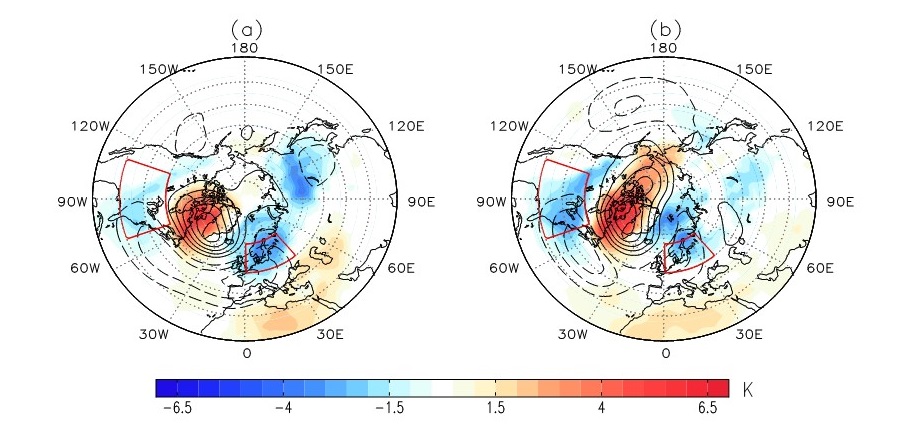Arctic Sea Ice Decline and Greenland Blockings Move: A New View of Global Warming Hiatus
Date:2017-05-19
Recent global-warming hiatus has attracted considerable interest from the scientific community. The negative anomalies observed over the Northern Hemisphere (NH) continents have received a wide attention as one key factor that leads to the winter warming hiatus. Previously, Prof. LUO Dehai from CAS Institute of Atmospheric Physics and his co-authors proposed that the recent frequent Eurasian extreme cold events are related to the increased quasi-stationarity and persistence of Ural blockings associated with the warming over the Barents and Kara seas. However, the physical cause of the cold anomaly over North America as a North American component of the winter warming hiatus was still unclear.

The time-mean composite 500-hPa geopotential height (contour) and SAT anomalies (shading) fields averaged from lag -5 to 5 days for (a) quasi-stationary Greenland blockings and (b) westward-moving Greenland blockings. (Image by IAP)
In a recent study, Prof. LUO and his postgraduate student, CHEN Xiaodan, found that the surface air temperature over the eastern North America and the North European is significantly influenced by the sea ice variability over the adjacent seas around Greenland (Baffin Bay, Davis Strait and Labrador Sea) through changing the movement of Greenland blockings.
Specifically, the westward-moving Greenland blocking (WGB) events increase significantly due to the weakened mid-high latitude westerly winds over Greenland and its upstream region because of a strong sea ice decline over the Baffin Bay, Davis Strait and Labrador Sea in the recent decade. For this case, intense cold anomalies are seen over the eastern North America. However, the less strong BDL sea ice decline is found to favor quasi-stationary Greenland blocking (QGB) events so that there are strong cold anomalies over the North Europe and central-eastern Asia (Fig. 1). Thus, it is concluded that the cold air outbreaks over the eastern North America should be more frequent under a strong declining condition of the BDL sea ice in the future.
This study has been published in Geophysical Research Letters (CHEN Xiaodan is the first author and Prof. LUO Dehai is the corresponding author), which was supported by the National Key Research and Development Program of China (2016YFA0601802).
Paper information:
Xiaodan Chen and Dehai Luo*, 2017: Arctic sea ice decline and continental cold anomalies: Upstream and downstream effects of Greenland blocking. Geophysical Research Letters. DOI: 10.1002/2016GL072387. http://onlinelibrary.wiley.com/doi/10.1002/2016GL072387/epdf
